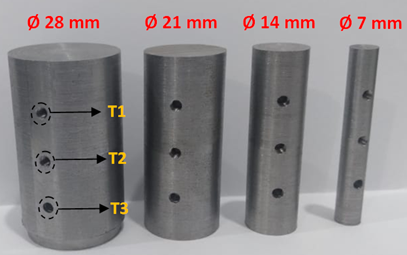Effect of power and diameter on temperature and frequency in induction heating process of AISI 4140 steel
Main Article Content
Abstract
This research aims to design an induction heating system and to investigate the effect of power supply and specimen diameter on specimen temperature and frequency on the coil. This study began with the development of an induction heating system that made use of circulating coolers outfitted with Thermoelectric Cooler Materials (TEC). It was intended to keep the temperature of the coil and the Printed Circuit Board (PCB) as low as possible. This study used AISI 4140 steel material with diameter variations of 7 mm, 14 mm, 21 mm, and 28 mm, with power levels of 60 W, 240 W, 540 W, and 960 W. The temperature was measured using a thermocouple connected to the specimen, and the frequency value obtained was measured using an oscilloscope. The research findings show that varying the applied power affects the frequency of the coil and the temperature of the specimen, with the higher the power, the faster the temperature of the specimen rises. The 60 W power can heat the specimen at an average temperature of 470°C and a frequency of 102 kHz. When the power variation is 960 W, the temperature in the specimen is 746°C, and the frequency is 110 kHz. On the temperature and frequency gradient pattern in the 0-600 s period, there are two stages, the first of which is ferromagnetic and the second of which is paramagnetic.
Downloads
Article Details

This work is licensed under a Creative Commons Attribution-NonCommercial 4.0 International License.
References
[2] K. Khoirudin et al., “A Report on Metal Forming Technology Transfer from Expert to Industry for Improving Production Efficiency,” Mechanical Engineering for Society and Industry, vol. 1, no. 2, pp. 96–103, 2021.
[3] Z. Malinowski, A. Cebo-Rudnicka, T. Telejko, B. Hadała, and A. Szajding, “Inverse method implementation to heat transfer coefficient determination over the plate cooled by water spray,” Inverse Problems in Science and Engineering, vol. 23, no. 3, pp. 518–556, 2015.
[4] J. Cochet, S. Thuillier, T. Loulou, N. Decultot, P. Carré, and P.-Y. Manach, “Heat treatment of 34CrNiMo6 steel used for mooring shackles,” The International Journal of Advanced Manufacturing Technology, vol. 91, no. 5, pp. 2329–2346, 2017.
[5] L. Bao, B. Wang, X. You, H. Li, Y. Gu, and W. Liu, “Numerical and experimental research on localized induction heating process for hot stamping steel sheets,” International Journal of Heat and Mass Transfer, vol. 151, p. 119422, 2020.
[6] W. Cai et al., “Promoting sustainability of manufacturing industry through the lean energy-saving and emission-reduction strategy,” Science of the Total Environment, vol. 665, pp. 23–32, 2019.
[7] P. Vishnuram, G. Ramachandiran, T. Sudhakar Babu, and B. Nastasi, “Induction Heating in Domestic Cooking and Industrial Melting Applications: A Systematic Review on Modelling, Converter Topologies and Control Schemes,” Energies, vol. 14, no. 20, p. 6634, 2021.
[8] M. C. Song and Y. H. Moon, “Coupled electromagnetic and thermal analysis of induction heating for the forging of marine crankshafts,” Applied Thermal Engineering, vol. 98, pp. 98–109, 2016.
[9] R. K. JANUTIENĖ and D. MAŽEIKA, “Modelling of induction heating of steel work piece for forging of crankshaft,” Materials Science, vol. 24, no. 3, pp. 345–350, 2018.
[10] S. M. Park, E. Jang, D. Joo, and B. K. Lee, “Power curve-fitting control method with temperature compensation and fast-response for all-metal domestic induction heating systems,” Energies, vol. 12, no. 15, p. 2915, 2019.
[11] R. Kocich, “Design and optimization of induction heating for tungsten heavy alloy prior to rotary swaging,” International Journal of Refractory Metals and Hard Materials, vol. 93, p. 105353, 2020.
[12] O. Lucía, P. Maussion, E. J. Dede, and J. M. Burdío, “Induction heating technology and its applications: past developments, current technology, and future challenges,” IEEE Transactions on industrial electronics, vol. 61, no. 5, pp. 2509–2520, 2013.
[13] K. Sandesh, R. K. Shishir, and C. V. Rao, “Optimization and comparison of induction heating and LPG assisted acid pretreatment of cocoa pod for ABE fermentation,” Fuel, vol. 262, p. 116499, 2020.
[14] J. Wang, B. Yi, C. Zhang, H. Zhou, and Y. Shu, “Experiments of double curvature plate bending with induction heating and processing parameters investigation by computational analysis,” Ocean Engineering, vol. 192, p. 106596, 2019.
[15] R. Smusz, T. Trzepiecinski, T. Malinowski, and T. Pieja, “Experimental investigations of induction heating in warm forming of stainless steel sheets,” Tehnički vjesnik, vol. 25, no. Supplement 2, pp. 312–318, 2018.
[16] I. Piroi, E. Spunei, C.-P. Chioncel, E. Răduca, and F. Piroi, “Controlling the variable frequency induction heating,” in 2016 International Conference on Applied and Theoretical Electricity (ICATE), 2016, pp. 469–473.
[17] N. Di Luozzo, M. Fontana, and B. Arcondo, “Modelling of induction heating of carbon steel tubes: Mathematical analysis, numerical simulation and validation,” Journal of Alloys and Compounds, vol. 536, pp. S564–S568, 2012.
[18] S. Mei et al., “Theoretical analysis of induction heating in high-temperature epitaxial growth system,” AIP Advances, vol. 8, no. 8, p. 85114, 2018.
[19] K. M. Lee, S. Y. Park, M. Y. Huh, J. S. Kim, and O. Engler, “Effect of texture and grain size on magnetic flux density and core loss in non-oriented electrical steel containing 3.15% Si,” Journal of magnetism and magnetic materials, vol. 354, pp. 324–332, 2014.
[20] V. Rudnev, D. Loveless, and R. L. Cook, Handbook of induction heating. CRC press, 2017.
[21] T. Todaka, T. Kishino, and M. Enokizono, “Low Curie temperature material for induction heating self-temperature controlling system,” Journal of Magnetism and Magnetic Materials, vol. 320, no. 20, pp. e702–e707, 2008.
[22] F. Aki, T. Loi, H. Saito, N. Yoshimura, and K. Mitobe, “Study of wireless temperature measurement induction heating system using magnetic properties of au‐coated ferromagnetic implant with low Curie temperature,” Electronics and Communications in Japan, vol. 101, no. 6, pp. 58–66, 2018.
[23] I. R. Valery, L. Don, and C. Raymond, “Handbook of Induction Heating: Manufacturing Engineering and Materials Processing.” CRC Press, 2002.

